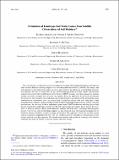Estimation of Landscape Soil Water Losses from Satellite Observations of Soil Moisture
Author(s)
McColl, Kaighin A.; Haghighi, Erfan; Salvucci, Guido D.; Akbar, Ruzbeh; Gianotti, Daniel J; Entekhabi, Dara; ... Show more Show less
Downloadjhm-d-17-0200.1.pdf (2.218Mb)
PUBLISHER_POLICY
Publisher Policy
Article is made available in accordance with the publisher's policy and may be subject to US copyright law. Please refer to the publisher's site for terms of use.
Terms of use
Metadata
Show full item recordAbstract
This study presents an observation-driven technique to delineate the dominant boundaries and temporal shifts between different hydrologic regimes over the contiguous United States (CONUS). The energy- and water-limited evapotranspiration regimes as well as percolation to the subsurface are hydrologic processes that dominate the loss of stored water in the soil following precipitation events. Surface soil moisture estimates from the NASA Soil Moisture Active Passive (SMAP) mission, over three consecutive summer seasons, are used to estimate the soil water loss function. Based on analysis of the rates of soil moisture dry-downs, the loss function is the conditional expectation of negative increments in the soil moisture series conditioned on soil moisture itself. An unsupervised classification scheme (with cross validation) is then implemented to categorize regions according to their dominant hydrological regimes based on their estimated loss functions. An east-west divide in hydrologic regimes over CONUS is observed with large parts of the western United States exhibiting a strong water-limited evapotranspiration regime during most of the times. The U.S. Midwest and Great Plains show transitional behavior with both water- and energy-limited regimes present. Year-to-year shifts in hydrologic regimes are also observed along with regional anomalies due to moderate drought conditions or above-average precipitation. The approach is based on remotely sensed surface soil moisture (approximately top 5 cm) at a resolution of tens of kilometers in the presence of soil texture and land cover heterogeneity. The classification therefore only applies to landscape-scale effective conditions and does not directly account for deeper soil water storage.
Date issued
2018-04Department
Massachusetts Institute of Technology. Department of Civil and Environmental Engineering; Massachusetts Institute of Technology. Department of Earth, Atmospheric, and Planetary SciencesJournal
Journal of Hydrometeorology
Publisher
American Meteorological Society
Citation
Akbar, Ruzbeh et al. “Estimation of Landscape Soil Water Losses from Satellite Observations of Soil Moisture.” Journal of Hydrometeorology 19, 5 (May 2018): 871–889 © 2018 American Meteorological Society
Version: Final published version
ISSN
1525-755X
1525-7541